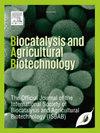Enhancing phosphorus availability and growth of green gram (Vigna radiata) in acidic red and laterite soil through liquid formulations of native phosphate solubilizing bacteria
IF 3.4
Q2 BIOTECHNOLOGY & APPLIED MICROBIOLOGY
引用次数: 0
Abstract
Phosphorus (P) availability in acid soils is often limited due to its fixation with various soil components. This leads to low use efficiency of P fertilizers and raises environmental concerns when they are used in excess. Phosphate-solubilizing bacteria (PSB) have the potential to enhance P availability by solubilizing insoluble P forms. In this study, twenty-five PSB strains were initially isolated from acidic red and laterite soils in eastern India. Among them, ten bacteria formed a clear halo zone in Pikovskaya agar plates. The P releasing ability of these bacteria from different insoluble P sources was evaluated. The PSB strain AJ14, identified as Enterobacter sp., exhibited high P releasing capacity from tri-calcium phosphate, rock phosphate, ferric phosphate, and aluminum phosphate. Additionally, the strain demonstrated the ability to release zinc and potassium from insoluble sources. To improve the shelf life and efficacy of the PSB strain, liquid biofertilizer formulations were developed using polymeric additives such as polyvinylpyrrolidone, polyethylene glycol, glycerol, carboxymethyl cellulose, and tween 20. The liquid formulations showed enhanced survival and viability of the PSB strain compared to solid carrier-based biofertilizers. In a pot culture experiment with green gram plants, the liquid formulations significantly increased soil available P, dry matter yield, and P uptake by plants compared to the control and solid carrier-based biofertilizer treatment. Mitscherlich equation parameters indicated the greater effectiveness of the liquid formulations. The results suggest that liquid formulations of the PSB strain AJ14 can improve P utilization efficiency and plant growth in acidic red and laterite soils.
通过原生磷酸盐溶解菌液体配方提高红壤和红土酸性土壤中磷的可用性和禾谷类作物(Vigna radiata)的生长能力
由于磷与土壤中各种成分的固定作用,酸性土壤中的磷(P)供应量往往有限。这导致磷肥的使用效率低下,并在过量使用时引发环境问题。磷酸盐溶解细菌(PSB)可通过溶解不溶性磷酸盐来提高磷的可用性。在这项研究中,最初从印度东部的酸性红土和红土土壤中分离出了 25 株 PSB 菌株。其中,有 10 种细菌在 Pikovskaya 琼脂平板上形成了明显的光晕区。对这些细菌从不同的不溶性 P 源释放 P 的能力进行了评估。被鉴定为肠杆菌的 PSB 菌株 AJ14 从磷酸三钙、磷矿石、磷酸铁和磷酸铝中表现出较高的 P 释放能力。此外,该菌株还能从不溶性来源中释放锌和钾。为了提高 PSB 菌株的保质期和功效,使用聚乙烯吡咯烷酮、聚乙二醇、甘油、羧甲基纤维素和吐温 20 等聚合物添加剂开发了液体生物肥料配方。与基于固体载体的生物肥料相比,液体制剂显示出更强的 PSB 菌株存活率和活力。在禾本科植物的盆栽培养实验中,与对照组和固体载体生物肥料处理相比,液体配方显著提高了土壤可利用钾、干物质产量和植物对钾的吸收。Mitscherlich 方程参数表明液体制剂的效果更好。结果表明,PSB 菌株 AJ14 的液体制剂可提高酸性红壤和红土中的钾利用效率和植物生长。
本文章由计算机程序翻译,如有差异,请以英文原文为准。
求助全文
约1分钟内获得全文
求助全文
来源期刊

Biocatalysis and agricultural biotechnology
Agricultural and Biological Sciences-Agronomy and Crop Science
CiteScore
7.70
自引率
2.50%
发文量
308
审稿时长
48 days
期刊介绍:
Biocatalysis and Agricultural Biotechnology is the official journal of the International Society of Biocatalysis and Agricultural Biotechnology (ISBAB). The journal publishes high quality articles especially in the science and technology of biocatalysis, bioprocesses, agricultural biotechnology, biomedical biotechnology, and, if appropriate, from other related areas of biotechnology. The journal will publish peer-reviewed basic and applied research papers, authoritative reviews, and feature articles. The scope of the journal encompasses the research, industrial, and commercial aspects of biotechnology, including the areas of: biocatalysis; bioprocesses; food and agriculture; genetic engineering; molecular biology; healthcare and pharmaceuticals; biofuels; genomics; nanotechnology; environment and biodiversity; and bioremediation.
 求助内容:
求助内容: 应助结果提醒方式:
应助结果提醒方式:


